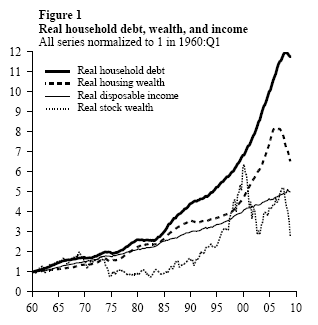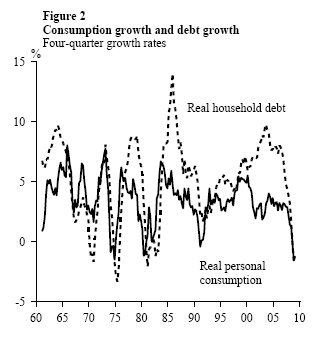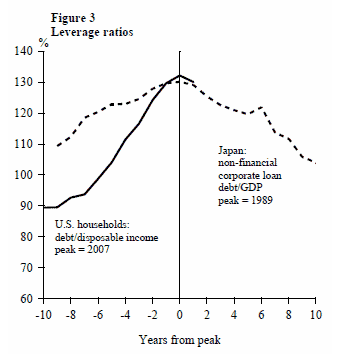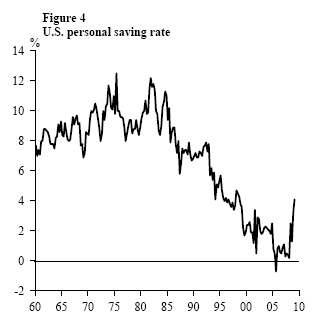U.S. household leverage, as measured by the ratio of debt to personal disposable income, increased modestly from 55% in 1960 to 65% by the mid-1980s. Then, over the next two decades, leverage proceeded to more than double, reaching an all-time high of 133% in 2007.
- U.S. household borrowing behavior
- How much deleveraging?
- Effect on saving and consumption
- Conclusion
- References
U.S. household leverage, as measured by the ratio of debt to personal disposable income, increased modestly from 55% in 1960 to 65% by the mid-1980s. Then, over the next two decades, leverage proceeded to more than double, reaching an all-time high of 133% in 2007. That dramatic rise in debt was accompanied by a steady decline in the personal saving rate. The combination of higher debt and lower saving enabled personal consumption expenditures to grow faster than disposable income, providing a significant boost to U.S. economic growth over the period.
In the long-run, however, consumption cannot grow faster than income because there is an upper limit to how much debt households can service, based on their incomes. For many U.S. households, current debt levels appear too high, as evidenced by the sharp rise in delinquencies and foreclosures in recent years. To achieve a sustainable level of debt relative to income, households may need to undergo a prolonged period of deleveraging, whereby debt is reduced and saving is increased. This Economic Letter discusses how a deleveraging of the U.S. household sector might affect the growth rate of consumption going forward.
History provides examples of significant deleveraging episodes, both in the household and business sectors, which offer a basis for gauging how debt reduction may affect spending. From 1929 to 1933, in the midst of the Great Depression, nominal debt held by U.S. households declined by one-third (see James and Sylla 2006). In a contemporary account, Persons (1930, pp. 118-119) wrote, “[I]t is highly probable that a considerable volume of sales recently made were based on credit ratings only justifiable on the theory that flush times were to continue indefinitely….When the process of expanding credit ceases and we return to a normal basis of spending each year,…there must ensue a painful period of readjustment.”
More recently, private nonfinancial firms in Japan reduced their debt relative to GDP by roughly 30 percentage points over 10 years following the bursting of twin bubbles in stocks and real estate in the early 1990s. Firms slashed their debt by significantly reducing the growth of investment spending.
U.S. household borrowing behavior
 Since 1960, the growth rate of real (inflation-adjusted) household debt in the United States has far outpaced the growth rates of real disposable income and real household wealth tied to either residential housing or stocks (Figure 1). A portion of long-run debt growth is likely attributable to credit industry innovation and product development that expanded consumer access to borrowed money.
Since 1960, the growth rate of real (inflation-adjusted) household debt in the United States has far outpaced the growth rates of real disposable income and real household wealth tied to either residential housing or stocks (Figure 1). A portion of long-run debt growth is likely attributable to credit industry innovation and product development that expanded consumer access to borrowed money.
Beginning in 2000, however, the pace of debt accumulation accelerated dramatically. Much of the run-up in debt was mortgage-related. During the decade, a combination of factors including low interest rates, weak lending standards, the spread of exotic mortgages, and the growth of a global market for securitized loans promoted increased borrowing.
Rising debt levels were accompanied by rising wealth. An influx of new and often speculative homebuyers with access to easy credit helped bid up prices to unprecedented levels relative to fundamentals, as measured by rents or disposable income. Equity extracted from rapidly appreciating home values provided hundreds of billions of dollars per year in spendable cash for households that was used to pay for a variety of goods and services.
The housing bubble burst in 2006. Since then, wealth tied to residential housing has declined dramatically. Wealth tied to stocks began to drop in 2007 with the onset of a financial crisis that triggered a global recession. Together, these events have wiped out a significant fraction of the collateral that previously helped support elevated levels of household debt.
Going forward, downward pressure on debt is likely to come from both lenders and households. On the supply side, tighter lending standards will require more income, collateral, and documentation for any given loan. Demand for mortgage debt could also wane as expectations of future house price appreciation are adjusted downward to reflect market conditions. Concerns about future job security and the risk of foreclosure or bankruptcy may spur consumers to boost their precautionary saving. Moreover, the need to rebuild nest eggs held for college education or retirement may prompt consumers to shift toward a more saving-oriented lifestyle.
 Figure 2 shows that real consumption and real debt growth have been strongly correlated since 1960. Rapid debt growth allowed consumption to grow faster than income. Conversely, if households were to go through a sustained period of deleveraging (negative debt growth), then consumption growth would be expected to slow.
Figure 2 shows that real consumption and real debt growth have been strongly correlated since 1960. Rapid debt growth allowed consumption to grow faster than income. Conversely, if households were to go through a sustained period of deleveraging (negative debt growth), then consumption growth would be expected to slow.
Since the start of the U.S. recession in December 2007, household leverage has declined. It currently stands at about 130% of disposable income. How much further will the deleveraging process go? In addition to factors governing the supply and demand for debt, the answer will depend on the future growth trajectory of the U.S. economy. While it’s true that Japanese firms and U.S. households may differ in important ways regarding decisions about paying down debt, the Japanese experience provides a recent example of a significant deleveraging episode that took place in the aftermath of a major real estate bubble and is useful as a benchmark.
The Japanese stock market bubble burst in late 1989, followed soon after by the bursting of the real estate bubble in early 1991. Nearly 20 years later, stock and commercial real estate prices remain more than 70% below their peaks, while residential land prices are more than 40% below their peak.

Note: Figure revised June 5, 2009.
Figure 3 compares Japan’s nonfinancial corporate sector with the U.S. household sector over 10-year periods before and after the leverage-ratio peaks. In both countries, leverage ratios rose rapidly in the years before the peak.
After Japan’s bubbles burst, private nonfinancial firms undertook a massive deleveraging, reducing their collective debt-to-GDP ratio from 125% in 1991 to 95% in 2001. By reducing spending on investment, the firms changed from being net borrowers to net savers. If U.S. households were to undertake a similar deleveraging, their collective debt-to-income ratio would need to drop to around 100% by year-end 2018, returning to the level that prevailed in 2002.
Effect on saving and consumption
Figure 4 shows that the U.S. personal saving rate has recently started to increase following a decades-long decline that bottomed out near zero in 2005. As described in Lansing (2005), the secular decline in the saving rate appears to have been driven, at least in part, by long-lived bull markets in stocks and housing. The recent price declines in these markets might therefore initiate a sustained rebound in the saving rate over time.
 A simple model of household debt dynamics can be used to project the path of the saving rate that is needed to push the debt-to-income ratio down to 100% over the next 10 years–a Japan-style deleveraging. Assuming an effective nominal interest rate on existing household debt of 7%, a future nominal growth rate of disposable income of 5%, and that 80% of future saving is used for debt repayment, the household saving rate would need to rise from around 4% currently to 10% by the end of 2018. A rise in the saving rate of this magnitude would subtract about three-fourths of a percentage point from annual consumption growth each year, relative to a baseline scenario in which the saving rate did not change. An even larger subtraction from consumption growth would occur relative to a baseline in which the saving rate were declining, as occurred prior to 2005. In either case, the subtraction from consumption growth would act as a near-term drag on overall economic activity, slowing the pace of recovery from recession.
A simple model of household debt dynamics can be used to project the path of the saving rate that is needed to push the debt-to-income ratio down to 100% over the next 10 years–a Japan-style deleveraging. Assuming an effective nominal interest rate on existing household debt of 7%, a future nominal growth rate of disposable income of 5%, and that 80% of future saving is used for debt repayment, the household saving rate would need to rise from around 4% currently to 10% by the end of 2018. A rise in the saving rate of this magnitude would subtract about three-fourths of a percentage point from annual consumption growth each year, relative to a baseline scenario in which the saving rate did not change. An even larger subtraction from consumption growth would occur relative to a baseline in which the saving rate were declining, as occurred prior to 2005. In either case, the subtraction from consumption growth would act as a near-term drag on overall economic activity, slowing the pace of recovery from recession.
More than 20 years ago, economist Hyman Minsky (1986) proposed a “financial instability hypothesis.” He argued that prosperous times can often induce borrowers to accumulate debt beyond their ability to repay out of current income, thus leading to financial crises and severe economic contractions.
Until recently, U.S. households were accumulating debt at a rapid pace, allowing consumption to grow faster than income. An environment of easy credit facilitated this process, fueled further by rising prices of stocks and housing, which provided collateral for even more borrowing. The value of that collateral has since dropped dramatically, leaving many households in a precarious financial position, particularly in light of economic uncertainty that threatens their jobs.
Going forward, it seems probable that many U.S. households will reduce their debt. If accomplished through increased saving, the deleveraging process could result in a substantial and prolonged slowdown in consumer spending relative to pre-recession growth rates. Alternatively, if accomplished through some form of default on existing debt, such as real estate short sales, foreclosures, or bankruptcy, deleveraging could involve significant costs for consumers, including tax liabilities on forgiven debt, legal fees, and lower credit scores. Moreover, this form of deleveraging would simply shift the problem onto banks that hold these loans as assets on their balance sheets. Either way, the process of household deleveraging will not be painless.
Reuven Glick
Group Vice President
Kevin J. Lansing
Senior Economist
James, John, and Richard Sylla. 2006. “Net Public and Private Debt, by Major Sector: 1916:1976.” In Historical Statistics of the United States: Earliest Times to the Present, ed. S. Carter, et al. New York: Cambridge University Press.
Lansing, Kevin J. 2005. “Spendthrift Nation.” FRBSF Economic Letter 2005-30 (November 10).
Minsky, Hyman P. 1986. Stabilizing an Unstable Economy. New Haven, CT: Yale University Press.
Persons, Charles E. 1930. “Credit Expansion, 1920 to 1929, and Its Lessons.” Quarterly Journal of Economics 45, pp. 94-130.
Opinions expressed in FRBSF Economic Letter do not necessarily reflect the views of the management of the Federal Reserve Bank of San Francisco or of the Board of Governors of the Federal Reserve System. This publication is edited by Anita Todd and Karen Barnes. Permission to reprint portions of articles or whole articles must be obtained in writing. Please send editorial comments and requests for reprint permission to research.library@sf.frb.org